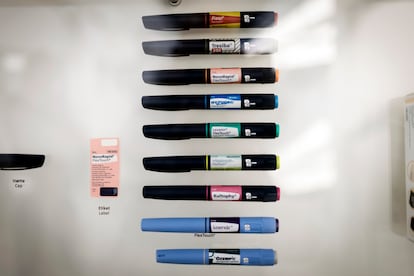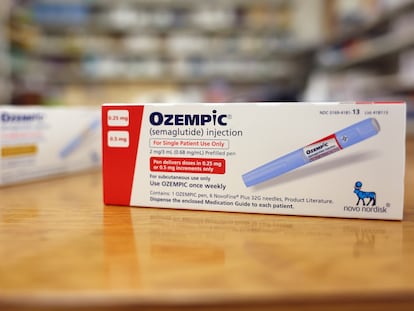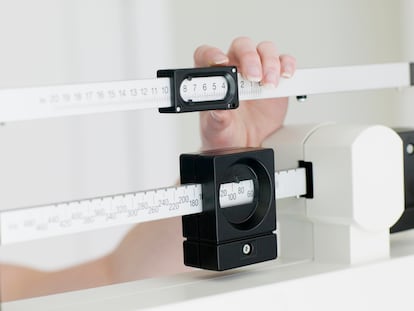Novo Nordisk’s meteoric rise: The fight against obesity wins over investors
The Danish pharmaceutical company has become the most valuable business in Europe thanks to its products that combat the disease, which the WHO believes has ‘acquired pandemic proportions’

Ozempic and Wegovy. Two drug names virtually unknown to the general public — except for doctors, patients and a handful of seasoned financial experts who follow the sector on the sidelines — are the stars of a 180-degree turn in the direction of a company (Novo Nordisk) and the economic sustainability of a country (Denmark) just when economic storm clouds are brewing in a Europe that is beginning to feel the effects of rising interest rates. The Copenhagen-based pharmaceutical company has become the most valuable company in Europe, after surpassing the French luxury giant LVMH and sneaking into the top 20 largest companies in the world. The Scandinavian country, for its part, has avoided a looming recession, in large part, to these two anti-obesity drugs made in Denmark.
To understand the meteoric rise of a once modest pharmaceutical laboratory specialized in diabetes, which today has almost 60,000 employees around the world, you have to go back almost seven years. It is January 2017. Novo Nordisk is the most valuable company in Denmark — one of the most prosperous nations in the European Union — but it is going through a stock market and business interregnum. Shares are stagnant, moving horizontally. There are, in short, few reasons to expect what is going to happen next: stocks will skyrocket, so high and so quickly, one would be mistaken for thinking Novo Nordisk was a chicharro — a Spanish term for small companies that have such low liquidity and capitalization that they are targeted by financial speculators who seek profit in their volatility — rather than a transatlantic cruise liner.
Everything changed when Lars Fruergaard Jørgensen, an executive with little aversion to risk, was appointed CEO of the company. As Novo Nordisk internally debated whether or not to continue with the very expensive trials to test the effectiveness of Wegovy against heart problems associated with obesity, the new CEO tipped the scales in favor of the drug. More than five years later, time has proved him right. The results, which were released last summer, were better than expected: the drug reduces the probability of heart attacks by 20%, even above what the market anticipated. The shares shot up, and the rest is history.
What’s more, Novo Nordisk struck bullseye twice. First with Wegovy, which is starting to gain ground, and secondly with Ozempic, which despite not yet being officially prescribed against obesity, already has a legion of users after it was touted by several Hollywood stars.
This double success could not have come at a better time. The arrival of the drugs coincides with a sharp rise in obesity levels in the West. According to the World Health Organization (WHO), it is reaching epidemic proportions. The United States is the epicenter of the health crisis, with two out of every five adults suffering from the disease. And Europe is not far behind: in the Old Continent it is already among the main causes of death and disability.
In 2023, Novo Nordisk’s revenue from Wegovy and Ozempic will more than double its value year-over-year. Those who closely follow the company believe revenue could balloon to $16 billion by 2027. The patents for both drugs still have some way to go: in most markets they will not expire until well into the 2030s. “We are only at the beginning,” predict Emily Field and Charles Pitman, from the British bank Barclays, which has just raised its forecasts for Novo Nordisk from 2024. “Obesity has become a secular and unique opportunity for the entire pharmaceutical sector, and, specifically, for Novo,” analysts from Deutsche Bank stated in a report published just after the Danish company overtook the iconic French group LVMH (which owns Louis Vuitton, Christian Dior and Moët Hennessy) as Europe’s most valuable listed company. The global icon of opulence was surpassed by the creator of an anti-obesity drug: two issues that have come to symbolize the modern world.
Markets, the old adage goes, reflect expectations and not profits. While Novo Nordisk is far from the most profitable pharmaceutical company in the world, it is the second-largest in the sector by stock market value, with a total worth of about $428 billion. The top spot is held by Eli Lilly, an American colossus which produces the drug Mounjaro, which is Wegovy’s main competitor. Eli Lilly’s market value is over $500 million: share prices have doubled in six months and quintupled since the Covid-19 lockdown. Eli Lilly is the 10th most valuable firm in the world, one step behind Meta (owner of Facebook) and ahead of Visa. Novo Nordisk, for its part, has increased its market value sixfold in the last decade. Its total worth has tripled since the pandemic and last year, it recorded growth of almost 75%.
Great potential
The potential market for anti-obesity drugs is enormous. Barclays recently valued it at around $100 billion over the next decade, indicating that the companies that entered the market first would receive the greatest rewards. “The market share should be split relatively equally between Novo Nordisk and Eli Lilly,” said Axelle Pinon, a member of the investment committee of the French asset manager Carmignac. The rest of the competitors, however, are not standing idly by. Pfizer — boosted by its success with the Covid-19 vaccine — also wants to join the race.
The market is there, and the challenge is, rather, how to satisfy demand. The boom has pushed its factories to the limit. The Danish company has announced it will spend $2 billion to scale up its facilities, and is considering opening a new plant specifically for Wegovy. “The company is struggling to meet demand outside the United States, even with increased production capacity. If the supply issues continue to prevail for an extended period, it could result in the loss of market share for the company,” warned Zacks Investment Research last week. That is the flip side of the pharmacological and business triumph: the ever-present risk of getting tripped up by your own success.
A century-old company
Novo Nordisk marks its 100th anniversary this year. The company has its origin in diabetes. In 1921, the Danish Nobel Prize winner August Krogh and his wife Marie, who suffered from this disease, learned of the discovery of insulin. August, aware of his wife's health problems, traveled to Canada and managed to secure permission to produce the medicine in Denmark. In 1923, the first patients in the country were treated with insulin.
A century later, Novo Nordisk is a global giant. Its sales in 2022 grew by 26% and stood at $25 billion, while operating profit rose by 16% and exceeded $10.6 billion. It is a very profitable company, since its operating margin stands at 42.3%. In addition, it distributes 50% of its profits in the form of dividends.
Tu suscripción se está usando en otro dispositivo
¿Quieres añadir otro usuario a tu suscripción?
Si continúas leyendo en este dispositivo, no se podrá leer en el otro.
FlechaTu suscripción se está usando en otro dispositivo y solo puedes acceder a EL PAÍS desde un dispositivo a la vez.
Si quieres compartir tu cuenta, cambia tu suscripción a la modalidad Premium, así podrás añadir otro usuario. Cada uno accederá con su propia cuenta de email, lo que os permitirá personalizar vuestra experiencia en EL PAÍS.
¿Tienes una suscripción de empresa? Accede aquí para contratar más cuentas.
En el caso de no saber quién está usando tu cuenta, te recomendamos cambiar tu contraseña aquí.
Si decides continuar compartiendo tu cuenta, este mensaje se mostrará en tu dispositivo y en el de la otra persona que está usando tu cuenta de forma indefinida, afectando a tu experiencia de lectura. Puedes consultar aquí los términos y condiciones de la suscripción digital.
More information
Archived In
Últimas noticias
Most viewed
- Alain Aspect, Nobel laureate in physics: ‘Einstein was so smart that he would have had to recognize quantum entanglement’
- Maps of the US attack on Venezuela: Targets, airspace and deployed fleet
- Oil, gold and rare earth elements: the backdrop to US political tension with Venezuela
- Key points of the military attack on Venezuela: Early morning bombings and a ‘captured’ president
- The US bombing of Venezuela, in pictures











































